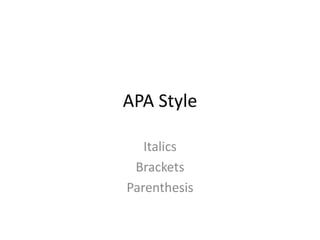
Apa style
- 1. APA Style Italics Brackets Parenthesis
- 2. Use of Italics • Titles of books, periodicals, films, videos, TV shows, and microfilm publications American Psychologist • Genera, species, and varieties Macaca mulatta • Introduction of a new, technical, or key term or label (after a term has been used once, do not italicize it) The term backward masking box labeled empty • A letter, word, or phrase cited as a linguistic example words such as big and small
- 3. Use of Italics (continued) • Words that could be misread the small group [meaning a designation, not group size] • Letters used as statistical symbols or algebraic variables a/b = c/d • Some test scores and scales MMPI scales: Hs, Pd • Periodical volume numbers in reference lists American Psychologist, 26, 46 – 67 • Anchors of a scale health ratings ranged from 1 (poor) to 5 (excellent)
- 4. Do Not Use Italics • Foreign phrases and abbreviations common in English a priori per se • Chemical terms NaCl • Trigonometric terms sin, tan, log • Nonstatistical subscripts to statistical symbols or mathematical expressions Fmax S +S A B
- 5. Do Not Use Italics (continued) • Greek letters β • Mere emphasis (Italics are acceptable if emphasis might otherwise be lost; in general, however, use syntax to provide emphasis) Incorrect: it is important to bear in mind… • Letters used as abbreviations intertrial interval (ITI)
- 6. Use Brackets • To enclose the values that are limits of a confidence interval 95% Cls [-7.2, 4.3], [9.2, 12.4], and [-1.2, -0.5] • To enclose material inserted in a quotation by some person other than the original writer “when *his own and others’+ behaviors were studied”
- 7. Use Brackets (continued) • To enclose parenthetical material that is already within parentheses (The results for the control group [n = 8] are also presented in Figure 2.) Exception 1: Do not use brackets if the material can be set of easily with commas. (as lmai, 1990, later concluded) Exception 2: In mathematical material, the placement of brackets and parentheses is reversed; that is, patentheses appear within brackets.
- 8. Do Not User Brackets • To set off statistics that already include parentheses Correct: was statistically significant, F(I, 32) = 4.37, p = 0.45 Incorrect: was statistically significant (F[I, 32] = 4.37, p = 0.45)
- 9. Use Parentheses • To set off structurally independent elements The patterns were statistically significant (see Figure 5). • To set of reference citations in text Dumas and Dore (1991) reported • To introduce an abbreviation effect on the galvanic skin response (GSR) • To set off letters that identify items in a series within a sentence of paragraph The subject areas included (a) synonyms associated with cultural interactions, (b) descriptors for ethnic group membership, and © psychological symptoms.
- 10. Use Parentheses (continued) • To group mathematical expressions (k – 1)/(g – 2) • To enclose the citation or page number of a direct quotation The author stated, “The effect disappeared within minutes” (Lopez, 1993, p.311) • To enclose numbers that identify displayed formulas and equations a = b + c (1)
- 11. Use Parentheses (continued) • To enclose statistical values was statistically significant (p = .031) • To enclose degrees of freedom F(2, 116) = 3.71
- 12. Do Not User Parentheses • To enclose material within other parentheses (the Beck Depression Inventory [BDI]) [Use brackets to avoid nested parentheses.] • Back to back Correct: (e.g. defensive pessimism; Norem & Cantor, 1986) Incorrect: (e.g. defensive pessimism) (Norem & Cantor, 1986)